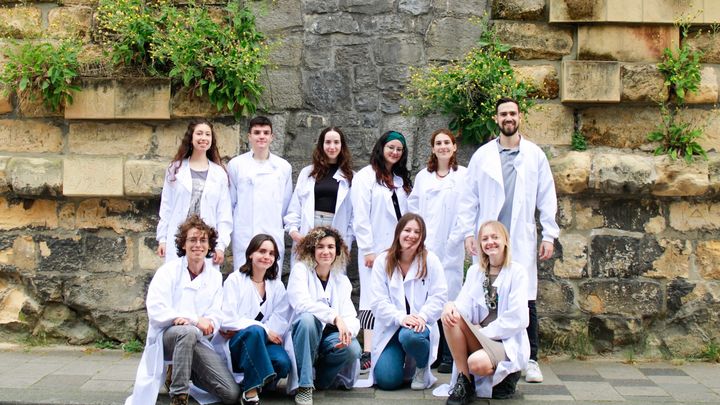
Restoring the limestone of Maastricht!
Donation protected
- Who are we?
SublimeStone is a team of 11 Maastricht University students ranging from different educational backgrounds, united by our shared enthusiasm for synthetic biology. We are currently working on a project for the iGEM (Internationally Genetically Engineered Machine) competition hosted by the Massachusetts Institute of Technology (MIT).
- What is our idea?
The aim of our project is to engineer bacteria that are capable of repairing cracks in limestone, conferring self-healing capabilities to stone structures. Our approach involves employing Escherichia coli (E. coli) bacteria capable of generating single-stranded DNA. Through complementary base pairing, these DNA strands will assemble into complex nanostructures by themselves. Once a sufficient amount of the single-stranded DNA is produced, our engineered bacteria will undergo programmed cell death, facilitating the release of DNA and allowing the formation of a stable DNA origami lattice. Small DNA fragments called staples are added to the medium our bacteria reside in and are used to interlock and strengthen the DNA origami lattice.
After our DNA origami lattice has formed, we will introduce another strain of bacteria, one that is capable of producing calcium carbonate, which is the major component of limestone. Since calcite contains positively charged components, it will naturally attach to the negatively charged DNA backbone of the DNA origami lattice. This will guide the mineralisation process of the calcite, and the resulting crystals will enhance the structural stability of the limestone, enabling the filling of cracks.
- Why did we choose this project?
As a Maastricht team, we recognise the importance of preserving the «Mergel », also known as Limburg limestone. This stone has been an integral part of the city's architectural history since Roman times, with its extraction starting in the 13th century from the limestone quarries found in the region. Notably, these quarries witnessed a remarkable event in history, the discovery of the Mosasaur now exposed in the Natural Science Museum of the city. Furthermore, during World War II, these same quarries served as shelters for people and secret hiding places for valuable paintings. The historical significance of the city lies in its association with limestone production, as the quarries were instrumental in the construction of landmarks such as the St Servaas Church, the red tower of Sint-Janskerk or even the city wall. Our city contains 1677 national heritage buildings, the second highest in the Netherlands after Amsterdam. By preserving this stone, we aim to safeguard our rich culture and continue to appreciate the monuments that make our city unique.
We chose this project as many of the historical sites made of limestone are slowly being weathered away. The porous nature of the stone and the rapid escalation of climate change have made these landmarks vulnerable to environmental factors such as acid rain or air pollutants. Currently, crack healing systems for stone structures involve the use of expensive epoxies. This approach can alter the appearance of the stone, requires ongoing maintenance and is highly polluting.
Thus, our team aspires to create a new tool to mitigate environmental degradation and restore structural integrity, ensuring the long-term conservation of our global cultural heritage for generations to come.
- How are we planning to implement it?
In order to implement our project, we would, first of all, ensure that our GMOs adhere to the Dutch government's national regulation 'Regeling genetisch gemodificeerde organismen milieubeheer 2013' (BWBR0035072).
Our goal is first to start putting our project into action in Maastricht in order to preserve the many monuments that have endured decades of weathering. Due to the abundant limestone resources, the Limburg province makes a perfect candidate for our technology, paving the way for our intention to expand its reach on a global scale.
Additionally, since DNA origami is still a novel technique, our work has the potential to contribute to other scientific fields, such as medicine, including bone repair and drug delivery.
- What will your donation be used for?
To turn our vision into a reality, we require financial support to cover laboratory expenses, research materials, equipment, and travel costs for presenting our findings at the Paris final conference. With your backing, we believe that our team can set a new precedent in monument conservation practices, showcasing the potential of synthetic biology to protect our shared cultural heritage.


Organizer
Erik Steen Redeker
Organizer
Brussels, BRU